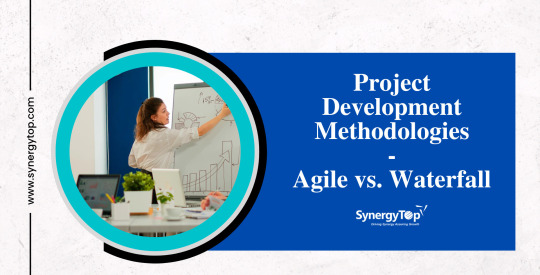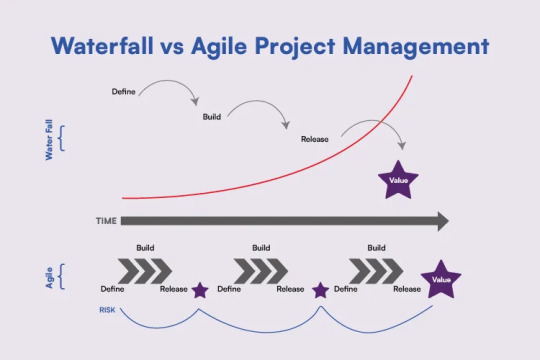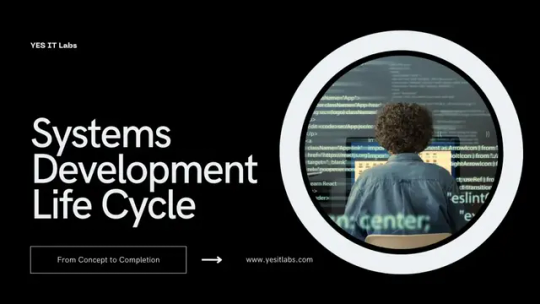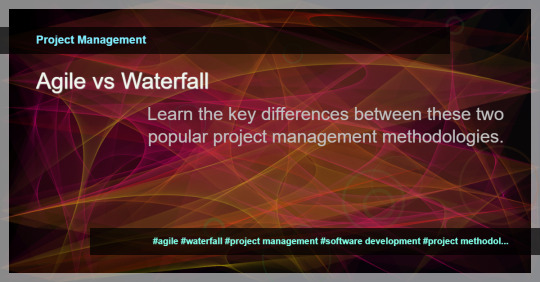#waterfall methodology
Explore tagged Tumblr posts
Text
Human Capital changes during COVID-19 Pandemic. Why software development methodologies shifted from Waterfall to Agile.
Iacob, Andreea Teodora (2024), Human Capital changes during COVID-19 Pandemic. Why software development methodologies shifted from Waterfall to Agile, IT & C, 3:4, pag, Abstract Human capital has encountered many challenges and changes during the COVID-19 Pandemic. This adaptability that we needed to embrace, to face the many challenges of the Pandemic context, has also increased the human…
#agile methodology#COVID-19#human capital#pandemic#social distance#software development#waterfall methodology
0 notes
Text
1 note
·
View note
Text
EVALUATING THE IMPACT OF PROJECT MANAGEMENT METHODOLOGIES ON HEALTHCARE IT IMPLEMENTATION
EVALUATING THE IMPACT OF PROJECT MANAGEMENT METHODOLOGIES ON HEALTHCARE IT IMPLEMENTATION 1.1 Introduction The rapid advancement of technology in healthcare has led to an increased focus on the implementation of Healthcare Information Technology (IT) systems, such as electronic health records (EHRs), telemedicine platforms, and patient management systems. However, the success of healthcare IT…
#Agile methodologies#EVALUATING THE IMPACT OF PROJECT MANAGEMENT METHODOLOGIES ON HEALTHCARE IT IMPLEMENTATION#healthcare IT#implementation#Mixed-methods research#PRINCE2#Project Management Methodologies#Project success#Scrum#Stakeholder engagement#Waterfall
0 notes
Text
Project Management Methodologies Compared: Which is Best Waterfall , Agile , Scrum, Kanban, Lean, Six Sigma or PRINCE2
Choosing the best project methodology depends on the nature of your project, team structure, and organizational culture. Waterfall offers a structured approach, while Agile and its subsets like Scrum and Kanban provide flexibility. Lean and Six Sigma focus on efficiency and quality, and PRINCE2 offers a comprehensive, scalable framework. Understanding the strengths and weaknesses of each methodology will help you navigate your projects to success.
#ProjectManagement hashtag#Methodologies hashtag#Agile hashtag#Scrum hashtag#Kanban hashtag#Waterfall hashtag#Lean hashtag#SixSigma hashtag#PRINCE2 hashtag#ProjectPlanning hashtag#ProjectSuccess hashtag#ManagementTechniques hashtag#ProjectEfficiency hashtag#BusinessStrategy hashtag#TeamManagement hashtag#ProjectLifecycle hashtag#WorkflowOptimization
0 notes
Text

Essential of SDLC: A Comprehensive Guide to Fundamentals, Phases, and Methodologies
Unlock the secrets of the Software Development Life Cycle with 'Decoding SDLC,' offering a comprehensive exploration of key fundamentals and methodologies.
#software development#sdlc#fundamentals#phases#agile methodologies#waterfall#development process#project management
0 notes
Text
Project Development Methodologies – Agile Vs. Waterfall | SynergyTop

Dive into the world of Project Development Methodologies with our latest blog at SynergyTop! 🚀 Explore the dynamic comparison between Agile and Waterfall approaches, uncovering the pros and cons of each in the realm of project management methodologies. 💡 Gain insights into choosing the right methodology for your projects. 🔄 Stay ahead in the development game with SynergyTop’s expert analysis. Read more at SynergyTop and elevate your project management strategy!
#agile vs waterfall#waterfall vs agile#project management methodologies#agile project management methodology#waterfall project management methodology#agile methodology pros and cons#waterfall and agile methodologies#project management methodologies comparison#pros and cons of waterfall methodology#difference between waterfall and agile methodology#agile project management#waterfall project management#difference between waterfall and agile
0 notes
Text

Agile methodology is a flexible and iterative strategy that allows teams to quickly adjust to changing project needs and deliver high-quality solutions in less time. In software development, agile is frequently utilized.
0 notes
Text

Discover the Systems Development Life Cycle (SDLC): From Concept to Completion
Explore the journey of the Systems Development Life Cycle from its inception to achieving project success. Acquire insights into the various stages, methodologies, and optimal approaches through this all-inclusive handbook.
#Systems Development Life Cycle (SDLC)#software systems#software applications#Software Development Company#Waterfall model#Agile methodologies
0 notes
Text
Understanding the Difference Between Agile and Waterfall Project Management
Introduction Agile and Waterfall are two popular project management methodologies used in software development and other industries. Both approaches have their own distinct characteristics and are employed in various contexts based on project requirements and team preferences. Waterfall Project Management Waterfall is a sequential and linear methodology in which project tasks are completed in a…

View On WordPress
0 notes
Text
Agile Vs Waterfall Methodology: Which Is the Best for Your Project?
"Choosing the right project methodology is key to success. Delve into the battle of Agile vs. Waterfall methodologies and find out which one aligns best with your project's unique needs. Unlock the power of efficient development and make informed decisions to propel your project forward." https://jumpgrowth.com/agile-vs-waterfall-methodology/
0 notes
Text

NAVIGATING PROJECT MANAGEMENT IN THE AEC INDUSTRY
Navigating Project Management in the AEC industry involves a series of interconnected tasks that require effective planning, execution, monitoring, and control. By following best practices and leveraging project management methodologies such as APM, SCRUM, KANBAN, or the Traditional WATERFALL Project Management Methodology, the AEC professionals can successfully deliver complex projects while meeting stakeholder expectations and achieving project objectives.
As an architectural manager with a Master of Architecture degree and an architectural engineering degree from reputable institutes, having experience in project and design management for large-scale commercial facilities, multi-story offices, and high-rise administration buildings, I can provide the necessary artifacts to enhance project success, improve team collaboration, and effectively handle project complexities in the architecture, engineering, and construction (AEC) sector.
1. Set Clear Goals and Objectives:
Define project scope, including deliverables and constraints.
Establish SMART (Specific, Measurable, Achievable, Relevant, Time-bound) goals.
Align goals with stakeholder expectations and project requirements.
Obtain buy-in from key stakeholders on project objectives.
2. Develop a Comprehensive Project Plan:
Create a detailed work breakdown structure (WBS) to organize project tasks.
Define project milestones and dependencies.
Develop a project schedule with timelines and resource allocation.
Identify risks and develop a risk management plan.
Establish a budget and financial plan for the project.
3. Foster Effective Communication:
Establish communication channels and protocols for project team members.
Hold regular project meetings to discuss progress, issues, and updates.
Use clear and concise language in all communications.
Encourage open and transparent communication among team members.
Address communication barriers and conflicts promptly.
4. Embrace Technology and Communication:
Utilize project management software for task tracking and collaboration.
Implement communication tools such as emails, instant messaging, and video conferencing.
Leverage cloud-based platforms for document sharing and version control.
Provide training and support for team members on project management tools.
Stay updated on new technologies and tools to improve project efficiency.
5. Manage Change Effectively:
Establish a change control process to evaluate and approve changes to project scope.
Communicate changes to stakeholders and assess their impact on project objectives.
Update project documentation and plans to reflect approved changes.
Monitor changes to prevent scope creep and ensure project alignment with goals.
Evaluate the risks and benefits of proposed changes before implementation.
6. Foster Collaboration and Teamwork:
Encourage team members to share ideas, feedback, and best practices.
Foster a collaborative work environment that values diversity and inclusivity.
Promote team building activities and recognize team achievements.
Facilitate cross-functional collaboration and knowledge sharing.
Resolve conflicts and promote a positive team culture.
7. Continuously Monitor and Evaluate Progress:
Track project performance against key performance indicators (KPIs).
Conduct regular project reviews to assess progress and identify areas for improvement.
Monitor project risks and issues and take corrective actions as needed.
Evaluate project outcomes against initial goals and objectives.
Use lessons learned to make informed decisions and optimize project performance.
By focusing on these subtasks within each point, project managers can enhance project success, improve team collaboration, and effectively manage project complexities in the Architecture, Engineering, and Construction (AEC) industry.
Sonetra KETH (កេត សុនេត្រា) •Architectural Manager, Project Manager, BIM Director •建築師經理, 專案經理, BIM總監 •Giám đốc kiến trúc, Giám đốc dựán, Giám đốc BIM •RMIT University Vietnam + Institute of Technology of Cambodia
#Pinned#Avatar#sonetra-keth#Badge image.#Nov 1#2023#Sonetra KETH#Architectural Manager#Project Manager#BIM Director#Thought Leadership#Design Management#Project Management#BIM Management#建筑师经理、专案经理、BIM总监#Giám đốc Kiến Trúc#Giám đốc Dựán#Giám đốc BIM#<meta name=“google-adsense-account” content=“ca-pub-9430617320114361”>#Sonetra Keth#blueprint#Inspired Urban Planning#Urban Planning Framework#crossorigin=“anonymous”></script>#កេត សុនេត្រា#នេត្រា#NETRA#netra#n8tra#N8TRA
5 notes
·
View notes
Text
Top Features to Look for in an App Development Company Arizona

Arizona's tech industry is buzzing with innovation, and mobile app development sits at the forefront. With countless App Development Companies in Arizona vying for your attention, choosing the right partner for your project can feel like navigating a maze. Worry not! This comprehensive guide from Net-Craft.com, a leading Custom App Development Arizona company located in Scottsdale, will equip you with the knowledge to identify the ideal Arizona App Developers to turn your vision into a reality.
Experience and Expertise: A Foundation for Success
Experience is a cornerstone when choosing an App Development Company Arizona. Here's what to consider:
Industry Experience: Look for a company with proven success in developing apps within your industry. Their knowledge of industry-specific challenges and opportunities will translate into a more effective app for your target audience.
Project Portfolio: Review the company's portfolio to assess the types of apps they develop and their design aesthetic. Do their past projects align with your vision and target audience?
Team Expertise: Inquire about the team's qualifications. Look for developers with experience in the technologies relevant to your app, especially developers familiar with the latest trends and innovations in mobile app development.
Client Testimonials & Reviews: Reading client testimonials and reviews can provide valuable insights into the company's communication style, development process, and ability to deliver results.
Development Process and Methodology: Understanding Your Roadmap
A transparent and well-defined development process is crucial. Ask potential App Development Companies in Arizona about:
Development Methodology: Agile and Waterfall are common methodologies. Understanding their preferred approach and its suitability for your project ensures a smooth development journey.
Communication Strategy: Clear communication is paramount. Will there be dedicated points of contact? How frequently will you receive updates? Ensure the company utilizes communication channels that suit your preferences.
Project Management Tools: Project management tools keep everyone on the same page. Ask about the tools they use and how they facilitate collaboration between you and the development team.
Customization and Scalability: Building an App that Grows with You
Your mobile app should adapt to your evolving needs. Look for an App Development Company Arizona that offers:
Custom App Development Arizona: Does the company develop custom apps from scratch, or do they offer pre-made templates? Custom development allows for a solution tailored entirely to your unique business requirements.
Scalability: Will your app need to handle increased user traffic in the future? Ensure the app architecture can be scaled to accommodate your growth ambitions.
Ongoing Support and Maintenance: Even after launch, your app will require maintenance and updates. Does the company offer ongoing support plans to keep your app functioning optimally?
Additional Considerations When Choosing an App Development Company Arizona
Cost and Pricing Structure: Pricing models for App Development Services in Arizona can vary. Obtain quotes from several companies and understand their pricing structure (e.g., hourly rate, project-based fees) to make an informed decision.
Location and Culture Fit: While not always essential, consider the advantages of partnering with a local Arizona App Developers company. Local proximity can facilitate easier communication and a deeper understanding of the Arizona market.
Company Culture: Does the company's culture resonate with yours? Look for a team with a collaborative and transparent approach that inspires trust and fosters a positive working relationship.
Net-Craft.com: Your Trusted Partner for Custom App Development Arizona
At Net-Craft.com, we understand the importance of aligning ourselves with your vision. We're a leading Custom App Development Arizona company known for our in-depth experience across various industries.
Here's what sets Net-Craft.com apart:
Dedicated Team of Experts: Our team comprises skilled designers, developers, and project managers passionate about crafting innovative and user-centric apps.
Agile Development Methodology: We employ an agile methodology to ensure flexibility and continuous improvement throughout the development process.
Focus on Communication: Clear and consistent communication is central to our approach. You'll receive regular updates and have dedicated points of contact to address any concerns.
Custom-Tailored Solutions: We don't believe in one-size-fits-all solutions. We take the time to understand your unique needs and develop a custom app that meets your specific objectives.
Long-Term Partnership: We believe in building long-term partnerships with our clients. We offer ongoing support and maintenance to ensure your app continues to thrive after launch.
Ready to Launch Your Dream App? Contact Net-Craft.com Today!
Choosing the right App Development Company Arizona is an investment in your app's success. Utilize these criteria to identify a partner who aligns with your vision, possesses the technical expertise, and fosters a collaborative partnership.
Net-Craft.com is committed to delivering exceptional mobile app development services in Arizona. We combine technical expertise with a passion for innovation to create cutting-edge apps that drive business growth.
Let's turn your app idea into a reality. Contact us today for a free consultation!
Know more https://www.net-craft.com/blog/2024/11/07/top-features-app-development-arizona/
#App Development Company Arizona#Arizona App Developers#Choosing an App Development Company#App Development Services Arizona#Custom App Development Arizona
3 notes
·
View notes
Text
How-To IT
Topic: Core areas of IT
1. Hardware
• Computers (Desktops, Laptops, Workstations)
• Servers and Data Centers
• Networking Devices (Routers, Switches, Modems)
• Storage Devices (HDDs, SSDs, NAS)
• Peripheral Devices (Printers, Scanners, Monitors)
2. Software
• Operating Systems (Windows, Linux, macOS)
• Application Software (Office Suites, ERP, CRM)
• Development Software (IDEs, Code Libraries, APIs)
• Middleware (Integration Tools)
• Security Software (Antivirus, Firewalls, SIEM)
3. Networking and Telecommunications
• LAN/WAN Infrastructure
• Wireless Networking (Wi-Fi, 5G)
• VPNs (Virtual Private Networks)
• Communication Systems (VoIP, Email Servers)
• Internet Services
4. Data Management
• Databases (SQL, NoSQL)
• Data Warehousing
• Big Data Technologies (Hadoop, Spark)
• Backup and Recovery Systems
• Data Integration Tools
5. Cybersecurity
• Network Security
• Endpoint Protection
• Identity and Access Management (IAM)
• Threat Detection and Incident Response
• Encryption and Data Privacy
6. Software Development
• Front-End Development (UI/UX Design)
• Back-End Development
• DevOps and CI/CD Pipelines
• Mobile App Development
• Cloud-Native Development
7. Cloud Computing
• Infrastructure as a Service (IaaS)
• Platform as a Service (PaaS)
• Software as a Service (SaaS)
• Serverless Computing
• Cloud Storage and Management
8. IT Support and Services
• Help Desk Support
• IT Service Management (ITSM)
• System Administration
• Hardware and Software Troubleshooting
• End-User Training
9. Artificial Intelligence and Machine Learning
• AI Algorithms and Frameworks
• Natural Language Processing (NLP)
• Computer Vision
• Robotics
• Predictive Analytics
10. Business Intelligence and Analytics
• Reporting Tools (Tableau, Power BI)
• Data Visualization
• Business Analytics Platforms
• Predictive Modeling
11. Internet of Things (IoT)
• IoT Devices and Sensors
• IoT Platforms
• Edge Computing
• Smart Systems (Homes, Cities, Vehicles)
12. Enterprise Systems
• Enterprise Resource Planning (ERP)
• Customer Relationship Management (CRM)
• Human Resource Management Systems (HRMS)
• Supply Chain Management Systems
13. IT Governance and Compliance
• ITIL (Information Technology Infrastructure Library)
• COBIT (Control Objectives for Information Technologies)
• ISO/IEC Standards
• Regulatory Compliance (GDPR, HIPAA, SOX)
14. Emerging Technologies
• Blockchain
• Quantum Computing
• Augmented Reality (AR) and Virtual Reality (VR)
• 3D Printing
• Digital Twins
15. IT Project Management
• Agile, Scrum, and Kanban
• Waterfall Methodology
• Resource Allocation
• Risk Management
16. IT Infrastructure
• Data Centers
• Virtualization (VMware, Hyper-V)
• Disaster Recovery Planning
• Load Balancing
17. IT Education and Certifications
• Vendor Certifications (Microsoft, Cisco, AWS)
• Training and Development Programs
• Online Learning Platforms
18. IT Operations and Monitoring
• Performance Monitoring (APM, Network Monitoring)
• IT Asset Management
• Event and Incident Management
19. Software Testing
• Manual Testing: Human testers evaluate software by executing test cases without using automation tools.
• Automated Testing: Use of testing tools (e.g., Selenium, JUnit) to run automated scripts and check software behavior.
• Functional Testing: Validating that the software performs its intended functions.
• Non-Functional Testing: Assessing non-functional aspects such as performance, usability, and security.
• Unit Testing: Testing individual components or units of code for correctness.
• Integration Testing: Ensuring that different modules or systems work together as expected.
• System Testing: Verifying the complete software system’s behavior against requirements.
• Acceptance Testing: Conducting tests to confirm that the software meets business requirements (including UAT - User Acceptance Testing).
• Regression Testing: Ensuring that new changes or features do not negatively affect existing functionalities.
• Performance Testing: Testing software performance under various conditions (load, stress, scalability).
• Security Testing: Identifying vulnerabilities and assessing the software’s ability to protect data.
• Compatibility Testing: Ensuring the software works on different operating systems, browsers, or devices.
• Continuous Testing: Integrating testing into the development lifecycle to provide quick feedback and minimize bugs.
• Test Automation Frameworks: Tools and structures used to automate testing processes (e.g., TestNG, Appium).
19. VoIP (Voice over IP)
VoIP Protocols & Standards
• SIP (Session Initiation Protocol)
• H.323
• RTP (Real-Time Transport Protocol)
• MGCP (Media Gateway Control Protocol)
VoIP Hardware
• IP Phones (Desk Phones, Mobile Clients)
• VoIP Gateways
• Analog Telephone Adapters (ATAs)
• VoIP Servers
• Network Switches/ Routers for VoIP
VoIP Software
• Softphones (e.g., Zoiper, X-Lite)
• PBX (Private Branch Exchange) Systems
• VoIP Management Software
• Call Center Solutions (e.g., Asterisk, 3CX)
VoIP Network Infrastructure
• Quality of Service (QoS) Configuration
• VPNs (Virtual Private Networks) for VoIP
• VoIP Traffic Shaping & Bandwidth Management
• Firewall and Security Configurations for VoIP
• Network Monitoring & Optimization Tools
VoIP Security
• Encryption (SRTP, TLS)
• Authentication and Authorization
• Firewall & Intrusion Detection Systems
• VoIP Fraud DetectionVoIP Providers
• Hosted VoIP Services (e.g., RingCentral, Vonage)
• SIP Trunking Providers
• PBX Hosting & Managed Services
VoIP Quality and Testing
• Call Quality Monitoring
• Latency, Jitter, and Packet Loss Testing
• VoIP Performance Metrics and Reporting Tools
• User Acceptance Testing (UAT) for VoIP Systems
Integration with Other Systems
• CRM Integration (e.g., Salesforce with VoIP)
• Unified Communications (UC) Solutions
• Contact Center Integration
• Email, Chat, and Video Communication Integration
2 notes
·
View notes
Text
Choosing the Pinnacle: A Guide to Selecting Optimal Mobile App Development Services

I. Introduction
In the fast-evolving digital era, mobile applications have become indispensable tools for businesses and individuals alike. However, the success of a mobile app heavily relies on the expertise and efficiency of the development services behind it. This article serves as a comprehensive guide to assist in the judicious selection of mobile app development services, ensuring the realization of a robust and successful application.
II. Understanding Your Project Requirements
Defining Project Scope
Crafting a successful mobile app starts with a meticulous definition of the project scope. This involves a detailed analysis of the desired functionalities and features, considering the unique needs of the target audience.
Platform and Technology Considerations
Choosing the right platforms (iOS, Android, or cross-platform) is pivotal. Additionally, selecting appropriate technologies and frameworks that align with the technical requirements of the project is crucial for its success.
III. Assessing Development Expertise
Portfolio Examination
A thorough review of the development company's portfolio is essential. This involves assessing past projects and industry experience, gauging the diversity and complexity of their work to ascertain their expertise.
Client Testimonials and Reviews
Client testimonials and reviews provide valuable insights into the reputation of a development company. Understanding client satisfaction levels, project management efficiency, and adherence to timelines is imperative.
IV. Development Methodologies and Practices
Agile vs. Waterfall Approaches
Choosing between Agile and Waterfall methodologies involves understanding their impact on project flexibility and adaptability. Selecting the most suitable approach is critical for seamless development.
Quality Assurance and Testing Procedures
The development company's approach to quality assurance and testing is paramount. Rigorous testing for functionality, security, and user experience ensures a polished and reliable final product.
V. Cost and Timeline Considerations
Transparent Pricing Models
Understanding different pricing models, including fixed, hourly, and dedicated team arrangements, is crucial. Ensuring transparency in cost breakdowns and anticipating potential additional charges is part of prudent decision-making.
Project Timeline Projections
Establishing realistic project timelines is essential for effective planning. Discussing milestones, deliverables, and potential setbacks ensures a clear roadmap for project completion.
This guide equips decision-makers with the insights needed to navigate the multifaceted process of selecting mobile app development services, laying the foundation for a successful and impactful mobile application.
4 notes
·
View notes
Text
Essential of SDLC: A Comprehensive Guide to Fundamentals, Phases, and Methodologies
Unlock the secrets of Software Development Life Cycle with 'Decoding SDLC,' offering a comprehensive exploration of key fundamentals and methodologies in 160 characters.
#software development#sdlc#agile methodologies#agile#waterfall#Development Process#project management
0 notes
Text
Businesses around the world are investing more resources into project management methodologies, tools, and training. But while technical skills and frameworks like Agile, Waterfall, and PRINCE2 are crucial, they are not enough on their own to guarantee project success. Increasingly, organizations are turning to project management coaching to build leadership capacity, sharpen soft skills, and elevate overall project performance.
Project management coaching is not just about teaching someone how to use a Gantt chart or follow a process. It’s a personalized, developmental approach aimed at helping project managers and their teams solve complex problems, improve interpersonal dynamics, and deliver better results. As projects become more cross-functional, virtual, and fast-paced, the demand for skilled project management coaches is rising steadily.
#ProjectManagement#ProjectCoaching#LeadershipDevelopment#PMO#AgileCoaching#ProjectSuccess#ProjectManagers#CoachingCulture#BusinessTransformation#ProfessionalDevelopment#ExecutiveCoaching#PMLeadership#ProjectTeams#ContinuousImprovement#ChangeLeadership
0 notes